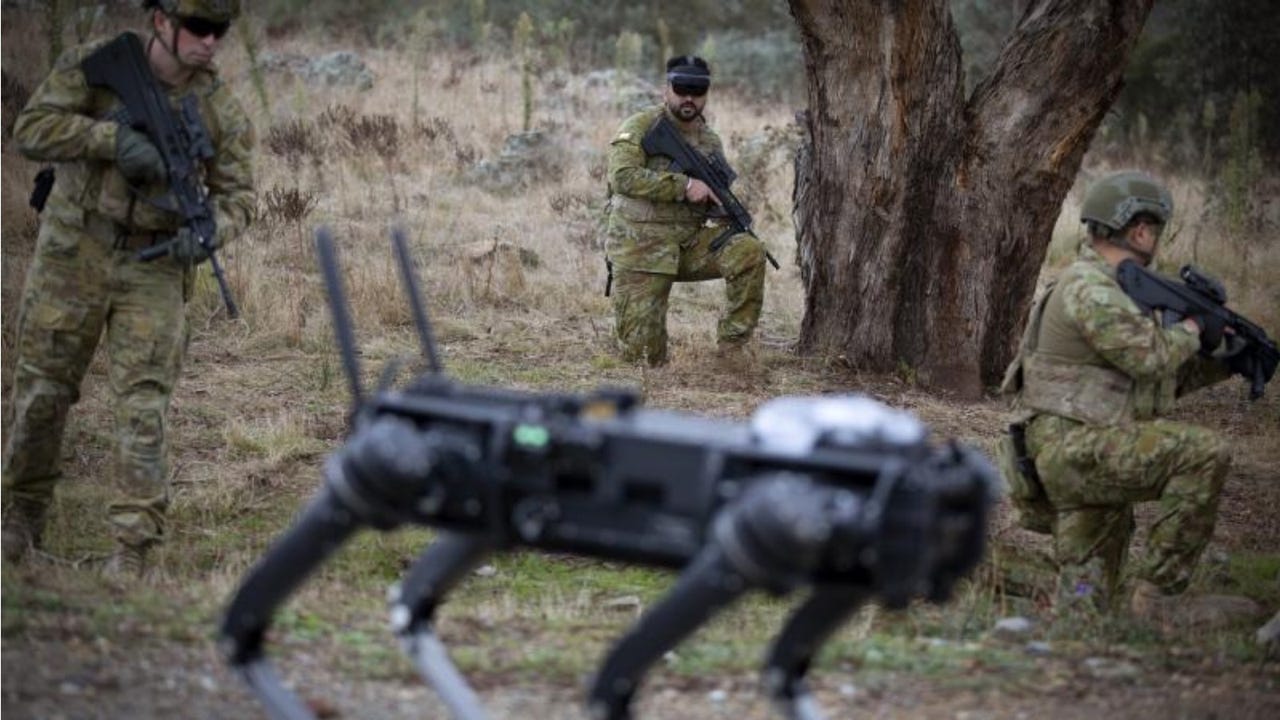
Scientists working with the Australian army have devised a way to control a Ghost Robotics quadruped robot with your thoughts.
Australian Army
My earliest and most vivid memory of machines fighting humans is the ostrich-like AT-AT Walkers from The Empire Strikes Back, walking herky-jerkily in formation, spitting hellfire in every direction while hoping to nail a Jedi or ten.
Since then, we’ve traversed the novelistic and cinematic terrains of cyborg-replicant servants, cyborg terminators traveling back in time, machines taking over the earth, robot cops, sentient cyborg sex-slaves, romance with AIs, robots who yearn to be real, and countless other variations, thanks to the vibrant, prescient imaginations of writers such as Philip K. Dick and George Lucas.
Also: Boston Dynamic’s robot dog learns new tricks to become a better coworker
Now, it appears some of these visions might not be so far-fetched — especially if you consider the arrival of the robot dog that can be controlled by your mind. Australian engineers Professor Chin-Teng Lin and Professor Francesca Iacopi, from the Sydney-based UTS Faculty of Engineering and IT, recently collaborated with the Australian army, as well as the country’s Defence Innovation Hub, on the design of a quadruped, dog-like robot made by Ghost Robotics that can be controlled using a brain-machine interface (BMI).
In other words, no special treats needed, just your thoughts transmitted via some sensors — and then this dog will actually do everything it is told to without a sound being emitted.
Mind over matter
This automated dog is not the only robot in town. In fact, it almost seems as if the effort to produce the ability to read thoughts has somehow tumbled all at once out of a loosely-latched innovation closet this year.
Just last month, scientists at University of Texas at Austin, conducted a pioneering experiment that made the world take notice. They placed a person in an MRI machine and made them listen to a story using headphones.
Also: What the ‘new automation’ means for technology careers
Meanwhile, using an AI system called a semantic decoder, they were able to generate the exact same text contained in the audio story by reading brain signals that the listener had generated while listening to the story.
Also last month, it was revealed that a man who was paralyzed from the neck downwards after a traffic accident, and was not expected to walk again, has been able to climb stairs thanks to a brain implant that ferries signals to his severed spine and back.
These experiments have almost overnight ushered in the era of the BMI, lauded for its potential in restoring function to victims of stroke and spinal-cord damage, revolutionizing healthcare along the way.
Also: How to use ChatGPT to write code
Elon Musk has long proclaimed that his BMI company Neuralink would pioneer the era of the human cyborg, only to have been eclipsed by several others along the way, such as Synchron. The company finally received clearance from the FDA last month.
No one, however, has received as much attention as the Australian Army and its ability to telepathically command a mechanized pooch.
All bite and no bark
One reason for this interest is because there are no invasive, fancy surgical processes involved here — and, therefore, no lengthy trials and long-term concerns about patient wellbeing.
Implants have always been a preferred go-to in BMIs because they are unobtrusive and eschew clunky equipment. Also, most non-invasive methods involve putting on a gloopy gel to attach them to your scalp, which is uncomfortable and can cause allergic reactions.
Also: More skills are needed to help AI plug skills gaps
Dry sensors seem to be the answer. But most are rigid and cannot really glom onto the curves of your head properly, and definitely not for lengthy periods.
The scientists involved in this study knew what they were up against. They had to conjure up something that mimicked the stickability of wet sensors sans gels, but were also hardy.
Their answer: transforming the normally flaky and rigid nanoparticle, graphene.
Also: 85% of business leaders would let a robot make their decisions
“By using cutting-edge graphene material, combined with silicon, we were able to overcome issues of corrosion, durability and skin contact resistance, to develop the wearable dry sensors,” said one of the lead scientists Francesca Iacopi.
As the study published in the journal ACS Applied Nano Materials describes, eight of these hexagonal sensors are integrated into a headband, which is positioned right above the occipital lobe, so it can intercept signals from the visual cortex.
Sensors behind the occipital lobe are able to intercept thoughts before sending the brain impulses to a computer.
ACS Appl. Nano Mater. 2023, 6, 7, 5440-5447
When a person dons an augmented reality headset displaying white square visual cues (HoloLens 2 in this case), the electrodes are able to discern which of them are being looked at.
The signals are then routed through a Raspberry Pi 4 Model B computer to modify them into commands, and then dispatched to the Q-UGVs bot dog from Ghost Robotics. There are nine different kinds of commands that can be fired off in just two seconds, from which the operator can chose one.
Also: I tried Apple Vision Pro and it’s far ahead of where I expected
All of this is done completely hands-free and with an astonishing 94% accuracy rate. You can watch a video of the Australian Army’s exercise using their robot dog here.
And the Army has had only glowing things to say about its newest member.
“This technology enables me to not only control the ghost robot as well as monitor its video feed,” Sergeant Chandan Rana of the 1st/15th Royal New Lancers says in a video, “but it allows me to be situationally aware of my surroundings as well as my team, to be able to control all movements on the battlefield clearance.”
Also: AI bots have been acing medical school exams, but should they become your doctor?
This robot dog might just be a support companion for an army today. But with full-scale conventional warfare thriving in an era of nuclear deterrence, it now seems only a matter of time — like drones before them — until robot armies are deployed on the battlefield, transforming the science and ethics of fighting like never before.


